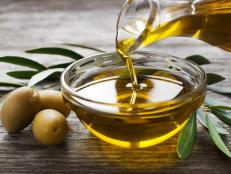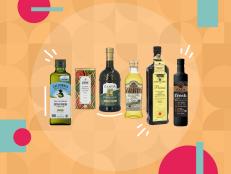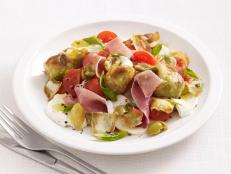How Much Olive Oil Should You Use When Cooking?
You don't want to overdo it — but there are ways to eyeball the measurements.


Floriana/Getty Images
One moment there’s a full bottle of olive oil; the next, you’re running to the store to re-stock. If this is a familiar feeling, you probably do a lot of cooking. Same. I’m not one to always follow a recipe, so I typically just glug the olive oil with abandon. Sometimes I worry though that I use too much olive oil. Should that bottle be lasting me longer? I decided to investigate this question, reader, for your benefit and mine. To do so, I considered two factors: nutrition and flavor.
I’ve always heard that olive oil is a healthy fat. But what, precisely does that mean? To answer this question, I consulted registered dietician, Food Network contributor and author of Healthy One Pan Dinners, Dana Angelo White, MS, RD, ATC. "Like most other plant-based oils, one tablespoon of olive oil contains 119 calories and 13.5 grams of total fat," Dana said. "There are 0 grams of protein, carbs, fiber and sodium, and olive oil is a good source of both vitamins E and K."
Although olive oil contains heart-healthy fats and has been linked to a protective effect against some types of cancer, too many healthy calories can still lead to excessive caloric intake. "For this reason, it’s important to measure out portions of olive oil for dressings and sauces and even when roasting and sautéing," Dana explained. To put things in perspective, although there are no specific recommendations for daily olive oil intake, very broadly, 25 to 30 percent of your caloric intake can come from fat — the majority coming from unsaturated "healthy" sources like olive oil.
Okay, but because it’s hard to do math every time you reach for the olive oil, here are some general rules about how much to use based on the sweet spot between nutrition (i.e. using minimal olive oil) and flavor.
Fundamentally, olive oil’s job is to conduct heat from the cooking surface to every nook and cranny of your food so cooks evenly and quickly. Therefore, if you’re cooking in a skillet, you need to use just enough oil to fully coat the entire bottom (unless you’re pan frying). That’s typically 1 to 2 tablespoons, depending on the size of your skillet. When you’re roasting, use enough to just fully coat the food you’re making. If using tablespoon measures feels cumbersome in this scenario, try this trick. Toss your food in olive oil and seasonings in a bowl — instead of directly on the baking sheet — then lift it out and transfer it to a baking sheet. Any extra oil will be left behind in the bottom of the bowl, don’t overthink it.
Related links:





























































